Scoutmaster Musings
Archives:
2023 2022 2021 2020 2019 2018 2017 2016 2015 2014 2013 2012 2011 2010 2009 2008 2007 2006 2005
2nd Quilt
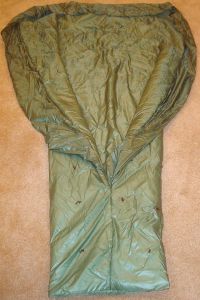 It may be too light for my AZ hike, but I expect it to be perfect for summer backpacking on the Ice Age Trail in Wisconsin. This sleeping quilt has only almost 1 inch of loft, but takes up a lot less space than my first quilt so it's tempting to try it earlier. I'll test it outside this weekend and see how warm I stay.
It may be too light for my AZ hike, but I expect it to be perfect for summer backpacking on the Ice Age Trail in Wisconsin. This sleeping quilt has only almost 1 inch of loft, but takes up a lot less space than my first quilt so it's tempting to try it earlier. I'll test it outside this weekend and see how warm I stay.It's green rip-stop nylon and a bit shorter and skinnier than my first in an effort to reduce weight. It weighs 1lb. 15oz. I was hoping it would weigh less, but I think the insulation I used is heavier for the amount of loft - in other words, not as good as expected.
The quality of insulation is really key to a warm quilt with less weight. Down has the best loft to weight ratio, but messy to work with, expensive, and loses loft when moist.
 This synthetic insulation will maintain loft better when wet which makes me a bit more comfortable on a long trek. Hopefully, I'll never find out just how well it holds up. :-)
This synthetic insulation will maintain loft better when wet which makes me a bit more comfortable on a long trek. Hopefully, I'll never find out just how well it holds up. :-)It only took me about 2 hours to make this quilt. Since it's mostly just long, straight stitches, there's not much to it. Keeping the many thick layers laying flat and in line is the most difficult part.
Fortunately, my neighbor had some extra brown yarn for the quilting laying around when I found out we had none. It's a good thing I'm leaving on my hike soon or I'd probably wind up making a third quilt somewhere between the first two in thickness.
Scout On
| Leave Comment |
Posted: 22:03 02-24-2012 753
DIY Pack
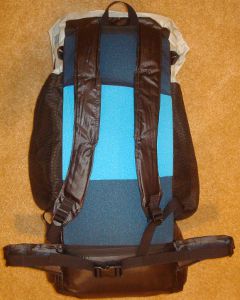 Yes, Mom, I made it myself!
Yes, Mom, I made it myself!With very little seam ripping and only two permanent alterations (mistakes), I've got my pack I plan to use for 2,000 miles this summer. It is a G4 pattern that I purchased online and sewed at home.
I've been hiking with the pack filled to about 24 pounds this past week and it carries just great. I've added cut pieces of 3/8inch foam pad to the shoulder straps and waistbelt instead of using socks and gloves for padding. I figured the extra 1.1oz. is worth the comfort, and it IS much more comfortable. I also just designed and made slip-on waistbelt pad extenders last night. These have a belt-wide strip of foam to cover my front hipbone that often gets bruised.
Here's more info:
- Weighs 12.2oz. plus 2.4oz of removable foam pad
- has about 4000 cubic inches
- top-loading main compartment and three large mesh outside pockets, plus 8 tie-on points
- has no frame - uses foam pad for support
- made of 2.2oz. grey rip-stop silnylon and black oxford
- adjustable shoulderstraps and waistbelt
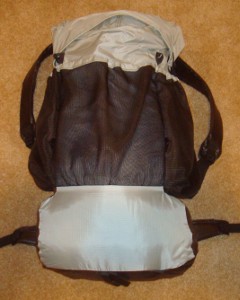 I made mine grey so it matches my quilt, hat, tent, and beard. ;-)
I made mine grey so it matches my quilt, hat, tent, and beard. ;-)It seems to have plenty of room for my main gear and I've not used the side pockets yet. I expect to fill those with water during my Arizona hike in a couple weeks. My sleeping quilt gets stuffed in first to fill the bottom and raise the heavy stuff up a bit. I don't squish the quilt down too much, but use the weight of gear above it to compress it down.
I just have one section of a blue foam pad for the back. Most people use a foam pad for sleeping and fold it up to provide the pack structure here. I'm using an inflatable pad instead, but it's 72 inches and I need 78 or my feet are on the ground. So, I lay the pack under my feet and have plenty of insulation and comfort there.
There is quite a bit of stress on the pack where the shoulder straps and waistbelt connect to the pack since this is where all the weight hits. I've double bartacked those points and the material seems to be plenty strong to handle the stress. I guess we'll see as I make my way from Mexico to Utah next month.
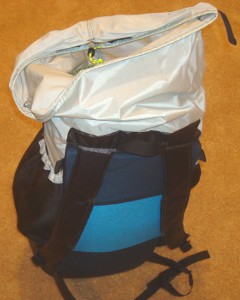
The top has a drawstring and two velcro strips to hold it shut. This top collar can also be extended up if you have a big load. But, be careful about overloading the pack - it's lightweight and should not have more than 25-30 pound load in it.
You can see how the pack top loads here. By packing sleeping gear first, you don't need to dig deep until it's time to set up camp. Keeping the daily needs, such as food, water, maps, hat, filter on top or in mesh pockets makes rest breaks easier to manage.
Oh, the two alterations I made?
- I attached the pack back and sides incorrectly which subtracted about 400 cubic inches of the bottom area.
- One seam on the collar faces out rather than in - I blame that one on the instructions, though.
Scout On
| Leave Comment |
Posted: 8:57 02-23-2012 752
2B2B
 2 Busy 2 Blog
2 Busy 2 BlogThis entire past week, I've been running back and forth, round and round, over and under. But, today I got to take a big breath and relax!
In a nutshell,
- Got a loaner sewing machine
- Finished sewing my backpack
- Sewed a 2nd sleeping quilt
- Hiked about 40 miles
- Presented CPR/AED training
- Presented Wilderness First Aid training
- Got a couple new supporters of my long hikes
- Met some great AZ Scouters online
- Gave neckerchief slide blanks and pocketknives to the troop
- Got new shoes for my AZ hike
I emailed some scoutmasters in Arizona, letting them know about my hike plans for the Arizona Trail and how they and their scouts can join my ScoutStrong Challenge - you can too. A couple troops are hoping to hike with me somewhere along the trail. A scouter might let me stay at his cabin. And, another might help me reach the trailhead and hike the first few days with me.
Whenever I interact with folks in the Scouting community, I'm always amazed at how supportive and helpful they are. When presenting my Red Cross training, it usually takes 10 minutes to clean everything up and pack my car when I'm with Scouters versus the 30 minutes or more when it's just the general public. It's a high bar you all set for the rest of us to reach - keep it up!
Scout On
| Leave Comment |
Posted: 13:12 02-21-2012 750
Don't Forget
 Between all your meetings, exercising to stay in shape, starting on taxes, deleting spam emails, checking out youtube videos, and the millions of other things that take up your time today - don't forget.
Between all your meetings, exercising to stay in shape, starting on taxes, deleting spam emails, checking out youtube videos, and the millions of other things that take up your time today - don't forget.Even if you hate chocolate - don't forget.
Even if you feel it's just a Hallmark Holiday - don't forget.
Even if you think killing flowers goes against Leave No Trace ethics - don't forget.
Scout On
(and don't forget)
| Leave Comment |
Posted: 9:08 02-14-2012 749
AZT Maps
 One step closer to being ready for the Arizona Trail.
One step closer to being ready for the Arizona Trail.I received a brand-new map set on CD of the entire 800+ miles of trail on Friday. The maps are 1:28,000 scale and each image prints on an 8.5x11 sheet.
These maps are very detailed and should be perfect for navigating. The AZT Association at aztrail.org has overview maps which are great for getting familiar with the trail, but not detailed enough for navigating.
Now that I have these maps and my compass, my navigation needs are met.
I spent yesterday printing and refilling my ink cartridge :-)
Printing front and back gives me 65 sheets to carry - that's almost a pound of paper! I plan to carry about a week's worth of maps at a time and ship the rest ahead in a bounce box. Every day, I hope to cover 3 pages of maps which is around 20 miles.
I'll mark spots where I take pictures or other interesting bits and then dump the used pages back in the bouncebox at the next resupply point.
These maps were created by, and being sold by ($25), Brett Tucker at simblissity.net but the profits go right to the AZ Trail Assocation for sustaining the trail. Brett has done an excellent job on an extremely useful project to benefit the hiking community.
Scout On
| Leave Comment |
Posted: 13:59 02-12-2012 748
Comments
Please send me an email if you have problems using the new Comments on the site. You should be able to comment on any page, not just blog posts.
Scout On
Scout On
| Leave Comment |
Posted: 10:26 02-11-2012 747
HBD, BSA
Posted: 12:24 02-08-2012 746
Two Good Turns
 I got to do my Good Turn yesterday and today.
I got to do my Good Turn yesterday and today.Shared some cooking secrets with another local troop last night. They've developed a bad habit of not cooking and the scoutmaster asked for some help.
After talking with them and finding out their best, worst, and usual camping meals, it sure looked like they were just not motivated to try anything interesting. I shared that there are some very easy, healthy, tasty, not messy recipes they could try if they want to expand their skills. A few thought some open fire cooking would be fun, especially Egg in an Orange and Pig on a Stick.
Their SPL is considering some cooking competition on their next campout so I hope they go ahead with that and push themselves.
 Tonight, I got to spend some quality time with a Webelos den working on their Readyman activity badge. I took my manikins, fake wounds, and first aid supplies and we all had a great time bandaging.
Tonight, I got to spend some quality time with a Webelos den working on their Readyman activity badge. I took my manikins, fake wounds, and first aid supplies and we all had a great time bandaging.These guys are excited to move on to Boy Scouts in a couple weeks. Next week, they get to carry the flags in at the City Council meeting and then they're crossing over.
It's refreshing to visit with Cub Scouts occasionally. The energy, silliness, and social pressures are so much different than Boy Scouts.
Scout On
| Leave Comment |
Posted: 21:14 02-07-2012 745
YAWRFAWE
 Yet Another Wilderness and Remote First Aid Week End
Yet Another Wilderness and Remote First Aid Week EndI spent the weekend with a dozen Scouting folks covering the first aid training required for all the BSA High Adventure bases now. We had everything from lightning deaths to mosquito bites so the 16+ hours went fairly quickly.
I've got a few more sessions scheduled around my long hikes, but they're full so I have to find room to add some more in May and June. I don't mind because I think it really is fun to facilitate and it's always a good refresher for me - especially since I'll be out alone for so many weeks this summer.
If you are looking for a new way to support Scouting, check with your local Red Cross chapter about becoming an instructor. They're often in need of more people and you get to meet a lot of great folks.
Scout On
PS: still waiting for my sewing machine gear.
| Leave Comment |
Posted: 14:17 02-06-2012 744
The System
 Do you know what this is? It's plastic, less than an inch across, and weighs hardly nothing. But, without it, I'm unable to complete my current sewing project. It's a top vertical gear from my sewing machine. Actually, it's a replacement that's on its way. Mine currently has a crack in it. The gear still works, but that small crack makes the gear a bit wider which causes the needle and bobbin to get out of sync. The sewing system is broken until a new gear shows up.
Do you know what this is? It's plastic, less than an inch across, and weighs hardly nothing. But, without it, I'm unable to complete my current sewing project. It's a top vertical gear from my sewing machine. Actually, it's a replacement that's on its way. Mine currently has a crack in it. The gear still works, but that small crack makes the gear a bit wider which causes the needle and bobbin to get out of sync. The sewing system is broken until a new gear shows up.Every system is made up of individual parts. Without just one of those parts, sometimes ones we don't appreciate or even consider, the whole system collapses. We pay attention to the obvious parts - the needle, presser foot, bobbin, spool in a sewing machine; the key, gas pedal, turn signal, speedometer in a car; the SPL, ASPL, and Scoutmaster in a troop. It's all those other parts that really need some attention occasionally.
A good system can last decades if it is maintained. My 1989 Mazda 323 refuses to die. I've cared for it for over 20 years by changing oil, checking fluids, and keeping the unseen pieces in good shape. My sewing machine is also over 20 years old. Once I replace this broken gear, I'll lubricate it and expect it to work another decade.
It's important to pay attention to all the parts that keep a system running. If a minor piece stops working, the system may struggle along for some time until you fix it. Or, worse even, you may just get used to that squeek, rattle, or misfire and do nothing about it until it all falls apart. In most mechanical systems, you monitor, lubricate, and replace parts to keep the system running.
A scout unit is a system, too, isn't it? By paying attention to all the pieces the risk of catastrophic failure is minimized. So, how can we keep all the pieces working well? Here's a few ideas, I expect you have more:
- Monitor Regularly ask for feedback. Find out from each person, individually, what's going well and not so well. Use the BSA monitoring tools, such as Journey to Excellence, to track performance.
- Lubricate Regularly thank every person for their contributions. In a large group, a list of names with date and reason you recognized them helps ensure no one is missed. It doesn't need to be a big deal; just a "Hey, Bob, thanks for that great flag raising" counts. An occasion celebration of the group's accomplishments also helps the whole group stay satisfied.
- Replace Regularly switch people in roles. Having different scouts, and adults, take on roles reduces wear and tear on individuals, gives more people experience, and gets new ideas into the unit.
Similar to a machine, monitoring, lubricating, and replacing can help keep a scout unit in top performance for decades. If you have the same people in the same roles year after year after year, something's bound to break.
Scout On
| Leave Comment |
Posted: 16:34 02-03-2012 742
MYOG Quilt
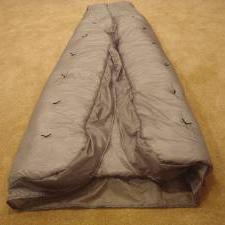 Heavy zippers, squished insulation, no wriggle room - who needs it?
Heavy zippers, squished insulation, no wriggle room - who needs it?I've finished my sleeping quilt for my first long hike. Even my wife was impressed at how nicely it turned out! From my point of view, it was very easy - so easy I'm making another one.
Sleeping quilts are making steady headway against sleeping bags, especially for long treks where light loads are desired. Actually, a lighter load is always a benefit no matter how long your trek is, but carrying a 4 pound bag for two days doesn't wear you down as badly as lugging it around for two weeks.
A quilt works by laying over the top of the backpacker and being tucked in on the sides as desired. Laying on a pad gives underneath insulation, just like when using a sleeping bag. There is a foot box area which keeps the quilt on and tucked in below.
 So, why the quilt? When you think about it, there are many benefits:
So, why the quilt? When you think about it, there are many benefits:- More Efficient - the insulation you lay on gets squished and loses its loft. That means it doesn't insulate. It's really just extra weight and expense.
- Lighter - no zipper, no insulation underneath, lighter fabric
- Flexible - the quilt can be wrapped around snugly or loosened up. It can be completely thrown off or lain on during warm nights. I can move my legs and body around without feeling quite so like a caterpiller.
- Customized - any MYOG (make your own gear) item can be made specifically to your size or needs. I made this quilt longer than normal and left off a part I didn't want.
I learned a lot from making this quilt.
I made it wider than I really need which means about 7 square feet of unnecessary fabric and insulation, which equals extra weight. My next one will be slimmed down.
It has about 2 inches of loft on top - that's a lot, just measure your own sleeping bag's thickness. My next one will have just about 1 inch for my summer trips with warmer nights.
It's very easy to make a quilt, and it doesn't need to be perfect. As long as you make sure the stitches are hitting all the layers of fabric, it turns out just fine.
I'll easily stay warm below freezing with this quilt. I'll try it on my back porch if we ever get some more cold weather, but I'd bet it will do just fine down to around 20 degrees and then I'd need to put on extra clothes. It weighs 2.5 pounds which I feel is fine for the range of temps I can use it in. The fabric is 1.1oz silnylon and the insulation is continuous filament polyester - goose down would be lighter, but messy working, more expensive, and susceptible to moisture.
I expect my second quilt to be good to around 40 degrees and weigh closer to 1 pound - but we'll see.
Scout On
| Leave Comment |
Posted: 14:17 02-02-2012 741
CDTA to Cease Operations
You may never hope or dream to hike the Continental Divide Trail, but this tidbit should be of interest to anyone that ventures into the wild places.
On the home page of the Continental Divide Trail Alliance, they've posted notice that the non-profit organization is ceasing operations and closing down over the next few weeks.
They mention the lack of financial support as being one key reason. It's no surprise that funding for wilderness recreation opportunities goes away as a non-essential expense. The CDT, as well as many other maintained trails, are used by a small portion of the population and are seen by many as unneeded. But, as the money wells dry up and individuals have fewer monetary resources, I expect we'll see additional wilderness and conservation organizations being forced to make similar decisions.
Please evaluate your personal contributions to groups that do good things. If you've got extra money, time, or resources that can be used to support a cause with which you agree, please don't put off getting involved until another day. That group may not be around another day.
Scout On
On the home page of the Continental Divide Trail Alliance, they've posted notice that the non-profit organization is ceasing operations and closing down over the next few weeks.
They mention the lack of financial support as being one key reason. It's no surprise that funding for wilderness recreation opportunities goes away as a non-essential expense. The CDT, as well as many other maintained trails, are used by a small portion of the population and are seen by many as unneeded. But, as the money wells dry up and individuals have fewer monetary resources, I expect we'll see additional wilderness and conservation organizations being forced to make similar decisions.
Please evaluate your personal contributions to groups that do good things. If you've got extra money, time, or resources that can be used to support a cause with which you agree, please don't put off getting involved until another day. That group may not be around another day.
Scout On
| Leave Comment |
Posted: 11:59 02-01-2012 740
Previous PostsComments:
Feb 25, 2023 - Joe Patterson
Just out of curiosity, are the Rockwell paintings on exhibit anywhere
Mar 16, 2023 - Adam John
Great question Joe! Have you checked out the Norman Rockwell Museum in
Stockbridge MA? (nrm.org) There is also the Rockwell Museum in Corning
NY. (rockwellmuseum.org) I believe the latter has more art. Hope this
helps!
Jan 21, 2024 - Johnna Downing
The Scouting museum at Philmont, Cimmaron, NM hopefully has the ones that
used to hang at the museum in Irving, TX. Good luck. Johnna
Scouting 2024 - Ask a Question - Add Content
Just for Fun: Socializing merit badge




This site is not officially associated with Scouting America
Find more Scouting Resources at www.BoyScoutTrail.com



 Hippo Birdie two Ewes, Boy Scouts of America!
Hippo Birdie two Ewes, Boy Scouts of America!
Follow Me, Scouts
Recent Comments